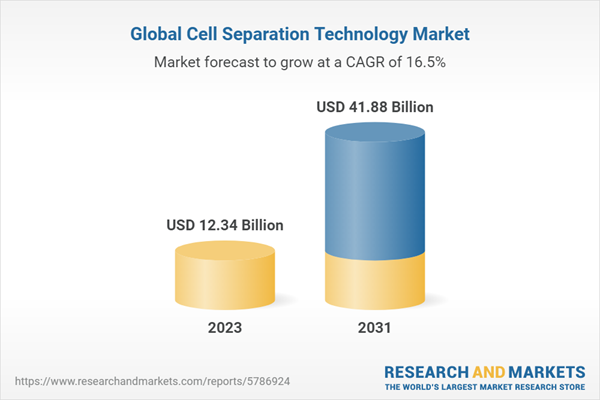Cell Separation Technology Market: Introduction
Cell separation technology is a method used to isolate specific cells or populations of cells from a mixed population. It is a technique that is widely used in the fields of biotechnology and medicine to isolate and study specific cell types, such as stem cells or immune cells.There are several methods of cell separation technology, including physical, chemical, and biological methods. Physical methods involve the use of physical forces, such as centrifugation or filtration, to separate cells based on their size, density, or other physical characteristics. Chemical methods use specific chemicals or ligands to separate cells based on their surface properties. Biological methods use specific antibodies or other biomolecules to selectively label, and separate cells based on their surface markers.
The uses of cell separation technology are varied and extensive. In basic research, cell separation is used to isolate and study specific cell types to better understand their function and behaviour. In clinical applications, cell separation technology is used to isolate and purify specific cells for transplantation or other therapeutic purposes. For example, stem cells can be isolated and purified using cell separation technology for use in regenerative medicine.
In addition, cell separation technology has important applications in diagnostics, particularly in cancer diagnosis and treatment. Cancer cells can be separated from normal cells using specific biomarkers, allowing for early detection and targeted therapy.
Cell Separation Technology Market Segmentations
Market Breakup by Product Type
- Instruments
- Centrifuges
- Flow Cytometers
- Filtration Systems
- Magnetic-activated Cell Separator Systems
- Others
- Consumables
- Reagents
- Kits
- Media
- Sera
- Beads
- Disposables
- Others
Market Breakup by Technology Type
- Immunomagnetic Cell Separation
- Fluorescence-activated Cell Sorting
- Density Gradient Centrifugation
- Microfluidic Cell Separation
- Others
Market Breakup by Cell Type
- Human Cells
- Animals Cells
Market Breakup by Applications
- Stem Cell Research
- Immunology
- Neuroscience
- Cancer Research
- Other
Market Breakup by End User
- Biotechnology and Pharmaceutical Companies
- Hospitals and Diagnostic Laboratories
- Academic and Research Institutes
- Others
Cell Separation Technology Market Breakup by Region
North America
- United States of America
- Canada
Europe
- United Kingdom
- Germany
- France
- Italy
- Others
Asia Pacific
- China
- Japan
- India
- ASEAN
- Australia
- Others
Latin America
- Brazil
- Argentina
- Mexico
- Others
Middle East and Africa
- Saudi Arabia
- United Arab Emirates
- Nigeria
- South Africa
- Others
Cell Separation Technology Market Scenario
The cell separation technology market has been driven by several key factors, including the increasing prevalence of chronic and infectious diseases, the growing demand for personalized medicine, and advancements in cell-based therapies.As the global population continues to age, the prevalence of chronic and infectious diseases is on the rise. This has led to a growing demand for more effective diagnostic tools and therapies, including those based on cell separation technology.
In addition, the trend towards personalized medicine has also driven market growth. With the increasing understanding of the genetic and molecular basis of diseases, there is a growing need for personalized treatments that target specific patient populations. Cell separation technology is a critical tool for isolating and studying specific cell populations, allowing for more targeted and effective therapies.
Advancements in cell-based therapies, such as CAR-T cell therapy, have also contributed to the growth of the cell separation technology market. These therapies require the isolation and purification of specific cell populations, which can be achieved through the use of cell separation technology.
Furthermore, the development of new technologies and products, such as microfluidics and magnetic-activated cell sorting (MACS), has also driven market growth. These new technologies offer improved accuracy and efficiency in cell separation, making the process faster and more reliable.
Overall, the cell separation technology market is expected to continue growing in the foreseeable future, driven by these key factors as well as increasing investment in research and development. The increasing demand for personalized medicine and the growing number of applications for cell separation technology are expected to drive market growth in the coming years.
Key Players in the Global Cell Separation Technology Market
The report gives an in-depth analysis of the key players involved in the cell separation technology market, sponsors manufacturing the drugs, and putting them through trials to get FDA approvals. The companies included in the market are as follows:- Terumo Corporation
- STEMCELL Technologies Inc
- Miltenyi Biotec
- Merck KGaA,
- Akadeum Life Sciences
- Thermo Fisher Scientific Inc
- BD
- Bio-Rad Laboratories
- Carl Zeiss AG
- General Electric
- QIAGEN
- IBA Lifesciences GmbH
- Elveflow
- MPR Associates
- PerkinElmer Inc
This product will be delivered within 5-7 business days.
Table of Contents
Companies Mentioned
- Terumo Corporation
- Stemcell Technologies Inc.
- Miltenyi Biotec
- Merck Kgaa,
- Akadeum Life Sciences
- Thermo Fisher Scientific Inc.
- Bd
- Bio-Rad Laboratories
- Carl Zeiss AG
- General Electric
- Qiagen
- Iba Lifesciences GmbH
- Elveflow
- Mpr Associates
- Perkinelmer Inc.
Table Information
| Report Attribute | Details |
|---|---|
| No. of Pages | 160 |
| Published | April 2023 |
| Forecast Period | 2023 - 2031 |
| Estimated Market Value ( USD | $ 12.34 Billion |
| Forecasted Market Value ( USD | $ 41.88 Billion |
| Compound Annual Growth Rate | 16.5% |
| Regions Covered | Global |
| No. of Companies Mentioned | 15 |









